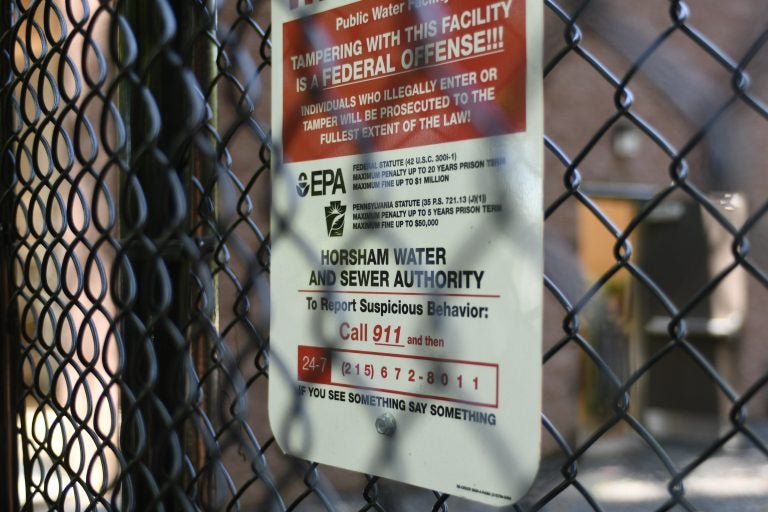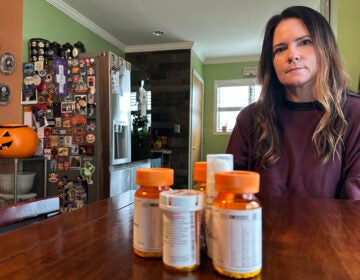The PFAS exposure study for Bucks and Montco has started. Here’s how to join
So far, 251 people have signed up. Researchers are seeking 1,000 adults and 300 children to participate.
Listen 2:46
Detailed view on the newly installed system to filter out PFAS Forever Chemicals at Well #2 of the Horsham Water and Sewer Authority facility in Horsham, Pa., on August 22, 2019. (Bastiaan Slabbers for WHYY)
Julie Cassidy has lived on a small street in Warminster for 24 years, and she’s noticed that some neighbors have developed different types of cancer. Her own husband died of a rare kind of leukemia.
Cassidy wonders if exposure to PFAS played any role in the sheer number of cancer diagnoses on her street.
“We have a man with a pediatric brain tumor going back almost 10 years ago. We have a very young girl, incredibly young, that had early onset breast cancer. My next-door neighbor had bladder cancer,” she said.
For decades, the toxic chemicals known as PFAS have contaminated groundwater, air, and soil in communities in this region and across the country, as well as waterways and the fish living in them.
These so-called forever chemicals — PFAS stands for per- and polyfluoroalkyl substances — are widely used in consumer products such as nonstick cookware, flame-retardant fabrics, and some food packaging. PFAS are also found in firefighting foam used at airports and current and decommissioned military bases, such as those in Bucks and Montgomery counties in Pennsylvania, at Joint Base McGuire-Dix-Lakehurst in New Jersey, and Dover Air Base in Delaware. The numerous health problems, including some cancers, linked to PFAS have led to lawsuits against the companies that make the products, such as DuPont and its successor companies, and 3M.
Cassidy recently submitted her health history, and blood and urine samples, to researchers who want to better understand the health outcomes of people exposed to PFAS. Seven areas across the United States were selected for the national study funded by the Centers for Disease Control and Prevention and the Agency for Toxic Substances and Disease Registry.
“I think there’s more power in knowing, and when the results come out, I think we would have more power in even being able to prevent such things in the future — for my children, my grandchildren,” Cassidy said. “I do find that some people have said that, ‘Oh, I don’t really want to know.’ ‘It makes me anxious.’ ‘What I don’t know can’t hurt me.’ But if we all looked at it that way, we would never find out the problems and then be able to correct them.”
In Montgomery and Bucks counties, researchers are recruiting people who lived near former and active military bases in Horsham, Warminster and Warrington between 2005 and 2017. These locations have a history of PFAS contamination, and residents there are concerned about what the long-term effects might be. Though efforts have been made to address the contamination, studies show that certain types of these chemicals can remain in the body for years.
So far, 251 people in this area have signed up for the study. Researchers from RTI International, the Pennsylvania Department of Health, Temple University, and Brown University are seeking 1,000 adults and 300 children to participate. Scientists will look for associations between PFAS exposure and various health conditions. After about a year, participants will receive their serum PFAS levels and the clinical results of their lab tests.
Researchers also are recruiting kids for a neurobehavioral assessment, which includes a series of learning and memory games, to understand if PFAS can cause cognitive and behavioral issues.
Residents interested in participating in the study can call 1-877-267-2890 to be screened for eligibility. Participants don’t have to be residents of Montgomery or Bucks counties, but must have lived there between 2005 and 2017, and be able to give blood samples at the research site in Warminster. More information can be found at papfas.rti.org. General questions can be sent to papfashealth@rti.org.
“To get your blood tested on your own, it’s not cheap, and insurance companies aren’t paying for it. So it’s an opportunity for people to get their blood tested for free. And I think it’s going to help science,” said Hope Grosse, co-founder of the Buxmont Coalition for Safer Water, which for several years has been advocating for clean water.
“I’m hoping that it could push laws in different ways to stop producing these chemicals -– because once they’re in the ground, they don’t leave the ground, and that is really scary,” said Grosse, who has helped recruit participants for the study.
“We know that the Department of Defense has polluted over 600 other sites in the United States, and I think at some point, somebody needs to be held accountable for this pollution. There’s cleanup and holding the polluter accountable, and then there’s our health, which I feel kind of has been on the back side of all this,” she said. “The Department of Defense isn’t really caring about our health and that people are dying and people are sick. So I think this is a first step in looking at illness and our health, which is super important.”
Jill Florin of Dresher, who has advocated for clean water for her community, said she is participating in the study to help researchers better understand the health risks of PFAS.
Florin said her late mother, who lived in Abington (another community affected by PFAS) had three types of cancer. She wonders if PFAS played a role in the diagnosis, because there was no family history of the types of cancers her mother had.
“I’m personally interested in registering because I would like to know if I have levels in my blood. Of course, the caveat to that is there’s nothing really we can do about that if you have a high level. But … I think it helps to have that piece of knowledge so that you know if you are more at risk of having certain health conditions or if you did have health conditions, could it be from the PFAS?” Florin said.
She also hopes the results of the study will help inform public health guidance and environmental regulations
“My hope is that if they show in this study that there is enough correlation between PFAS levels and health issues, that maybe it will push the government in the direction of definitely having a maximum contaminant level for PFAS, and therefore it would be a regulated thing and we would not be able to have the higher levels in our water,” Florin said.
Linda Morris Brown, senior research epidemiologist from RTI International, said she hopes that the study will lead to still more PFAS research.
“I hope it’ll lead to studies that can look more closely at these associations that seem to be coming up in this study with a really high-powered study designed where there’s like a case control study or something that can actually have a specific defined hypothesis for different diseases,” she said.
“Our study design is just saying, ‘What connection is there potentially between PFAS, water exposure, and health?’ [The next one] would say, ‘Our hypothesis is that PFAS is related to xyz disease, so we are going to get cases of xyz disease and then we’re going to then look at their PFAS level,” Brown said. “So the idea of this study is to really generate a lot of hypotheses, and then further research to really fine-tune, hopefully, the ones that looked the most promising and then ultimately be able to give more guidance, and maybe even hopefully some prevention strategies.”

Saturdays just got more interesting.
WHYY is your source for fact-based, in-depth journalism and information. As a nonprofit organization, we rely on financial support from readers like you. Please give today.







